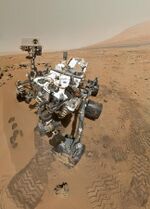Astronomy:Kepler-88
| Observation data Equinox J2000.0]] (ICRS) | |
|---|---|
| Constellation | Lyra |
| Right ascension | +19h 24m 35.5431s[1] |
| Declination | +40° 40′ 09.8098″[1] |
| Apparent magnitude (V) | 13.5[2] |
| Characteristics | |
| Spectral type | G8IV or B[3] |
| Astrometry | |
| Proper motion (μ) | RA: 1.114±0.023[1] mas/yr Dec.: 4.963±0.028[1] mas/yr |
| Parallax (π) | 2.6246 ± 0.0140[1] mas |
| Distance | 1,243 ± 7 ly (381 ± 2 pc) |
| Absolute magnitude (MV) | 5.183+0.116 −0.090[4] |
| Details | |
| Mass | 1.022+0.023 −0.026[4] M☉ |
| Radius | 0.961+0.020 −0.024[4] R☉ |
| Luminosity | 0.755+0.056 −0.067[4] L☉ |
| Surface gravity (log g) | 4.482+0.018 −0.016[4] cgs |
| Temperature | 5513±67[4] K |
| Metallicity [Fe/H] | +0.37 ± 0.08[4] dex |
| Rotation | 30.689±0.383 days[5] |
| Age | 2.45+1.20 −0.77[4] Gyr |
| Other designations | |
| Database references | |
| SIMBAD | data |
| KIC | data |
Kepler-88 is a Sun-like star in the constellation of Lyra, with three confirmed planets. In April 2012, scientists discovered that a Kepler candidate known as KOI-142.01 (Kepler-88b) exhibited very significant transit-timing variations caused by a non-transiting planet.[4] Timing variations were large enough to cause changes to transit durations to Kepler-88b as well. Large transit-timing variations helped to put tight constraints to masses of both planets. The non-transiting planet was further confirmed through the radial velocity method in November 2013.[7]
Planetary system
Kepler-88b is the innermost planet in the system and is Neptune-sized but almost half as dense.
Kepler 88c is about 60% as massive as Jupiter, but its radius is not known due to not transiting the planet.
Kepler-88d orbits its star every four years, and its orbit is not circular, but elliptical. At three times the mass of Jupiter, it is the most massive.[8] It was discovered based on six years of radial velocity (RV) follow-up from the W. M. Keck Observatory High Resolution Echelle Spectrometer spectrograph.[9]
| Companion (in order from star) |
Mass | Semimajor axis (AU) |
Orbital period (days) |
Eccentricity | Inclination | Radius |
|---|---|---|---|---|---|---|
| b | 0.09604+0.00063−0.00066 MJ | 0.098 | 10.91647±0.00014 | 0.05561±0.00013 | 90.97±0.12° | 3.780 R⊕ |
| c | 0.656+0.027−0.026 MJ | 0.15525 | 22.26492±0.00067 | 0.05724±0.00045 | 93.15±0.68° | — |
| d | ≥3.15±0.15 MJ | 2.45±0.02 | 1409+14−13 | 0.424+0.031−0.032 | — | — |
References
- ↑ 1.0 1.1 1.2 1.3 1.4 Brown, A. G. A. (August 2018). "Gaia Data Release 2: Summary of the contents and survey properties". Astronomy & Astrophysics 616: A1. doi:10.1051/0004-6361/201833051. Bibcode: 2018A&A...616A...1G. Gaia DR2 record for this source at VizieR.
- ↑ "Notes on Kepler-88 b". Extrasolar Planets Encyclopaedia. http://exoplanet.eu/catalog/kepler-88_b/.
- ↑ "Kepler-88". http://simbad.u-strasbg.fr/simbad/sim-id?Ident=Kepler-88.
- ↑ 4.0 4.1 4.2 4.3 4.4 4.5 4.6 4.7 4.8 Nesvorný, David; Kipping, David; Terrell, Dirk; Hartman, Joel; Bakos, Gáspár Á; Buchhave, Lars A (2013). "KOI-142, the King of Transit Variations, is a Pair of Planets Near the 2:1 Resonance". The Astrophysical Journal 777 (1): 3. doi:10.1088/0004-637X/777/1/3. Bibcode: 2013ApJ...777....3N.
- ↑ McQuillan, A.; Mazeh, T.; Aigrain, S. (2013). "Stellar Rotation Periods of The Kepler objects of Interest: A Dearth of Close-In Planets Around Fast Rotators". The Astrophysical Journal Letters 775 (1): L11. doi:10.1088/2041-8205/775/1/L11. Bibcode: 2013ApJ...775L..11M.
- ↑ "Kepler-88". SIMBAD. Centre de données astronomiques de Strasbourg. http://simbad.u-strasbg.fr/simbad/sim-basic?Ident=Kepler-88.
- ↑ SOPHIE velocimetry of kepler transit candidates:X KOI-142c: first radial velocity confirmation of a non-transiting exoplanet discovered by transit timing: S.C.C. Barros (1), R. F. Diaz, A. Santerne, G. Bruno, M. Deleuil, J.M. Almenara, A.S. Bonomo, F. Bouchy, C. Damiani, G. Hebrard, G. Montagnier, C. Moutou (1- Laboratoire d'astrophysique de Marseille)2
- ↑ "Newly discovered planetary system". COSPAR Information Bulletin 2002 (154): 8–9. August 2002. doi:10.1016/s0045-8732(02)80068-7. ISSN 0045-8732. Bibcode: 2002CIBu..154....8..
- ↑ 9.0 9.1 Weiss, Lauren M.; Fabrycky, Daniel C.; Agol, Eric; Mills, Sean M.; Howard, Andrew W.; Isaacson, Howard; Petigura, Erik A.; Fulton, Benjamin et al. (2020-04-29). "The Discovery of the Long-Period, Eccentric Planet Kepler-88 d and System Characterization with Radial Velocities and Photodynamical Analysis". The Astronomical Journal 159 (5): 242. doi:10.3847/1538-3881/ab88ca. ISSN 1538-3881. Bibcode: 2020AJ....159..242W. https://authors.library.caltech.edu/99954/1/1909.02427.pdf.
 |



